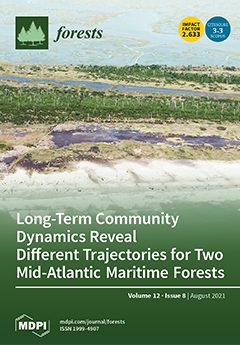Many factors govern the flow of deposited nitrogen (N) through forest ecosystems and into stream water. At the Fernow Experimental Forest in WV, stream water nitrate (NO
3−) export from a long-term reference watershed (WS 4) increased in approximately 1980 and has remained elevated despite more recent reductions in chronic N deposition. Long-term changes in species composition may have altered forest N demand and the retention of deposited N. In particular, the abundance and importance value of
Acer saccharum have increased since the 1950s, and this species is thought to have a low affinity for NO
3−. We measured the relative uptake of NO
3− and ammonium (NH
4+) by six important temperate broadleaf tree species and estimated stand uptake of total N, NO
3−, and NH
4+. We then used records of stream water NO
3− and stand composition to evaluate the potential impact of changes in species composition on NO
3− export. Surprisingly, the tree species we examined all used both mineral N forms approximately equally. Overall, the total N taken up by the stand into aboveground tissues increased from 1959 through 2001 (30.9 to 35.2 kg N ha
−1 yr
−1). However, changes in species composition may have altered the net supply of NO
3− in the soil since
A. saccharum is associated with high nitrification rates. Increases in
A. saccharum importance value could result in an increase of 3.9 kg NO
3−-N ha
−1 yr
−1 produced via nitrification. Thus, shifting forest species composition resulted in partially offsetting changes in NO
3− supply and demand, with a small net increase of 1.2 kg N ha
−1 yr
−1 in NO
3− available for leaching. Given the persistence of high stream water NO
3− export and relatively abrupt (~9 year) change in stream water NO
3− concentration circa 1980, patterns of NO
3− export appear to be driven by long-term deposition with a lag in the recovery of stream water NO
3− after more recent declines in atmospheric N input.
Full article





